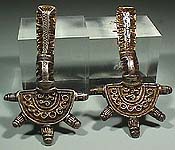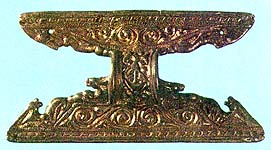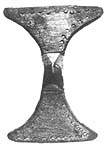 |
||||||||||||||||||||
|
Lesson #5: Page 3
Cruciform Brooches
The three principal divisions may be recognized in the brooch; the head-plate, the arched bow and the foot. The cruciform outline is completed by a pair of lateral wings which emerge from the head plate, the form being accentuated by the presence of three knobs, one on the top of the head plate and one at the extremity of either wing; these in turn may each have decorative extensions projecting from them. On some early brooches these lateral extensions of the head-plate are functional in that they carry the pin axis, but on most examples they are purely decorative. Variations occur on all these elements, some of which evidently have chronological implications, while in others instances indications of a linear progression seem to defy detection. The relative importance ascribed to the head plate and wings is striking in its variety. In the earliest forms, which remain rare in England, the wings may be absent altogether. Later types vary in the form of the head-plate (which may be trapezoid or square, and differentiated from the wings by a step or by rows of punch marks, or it may be undifferentiated) and the wings (which may be narrow and rectangular or wide with a markedly flaring outline). The top-knob is generally cast as an integral part of the brooch, but examples occur which are attached by means of a projecting tab with a stud on the underside which engages with the head plate, the whole perhaps secured with solder. The side knobs too may be cast with the brooch, but others are (presumably0 soldered on and held in place by an iron pin; such pins are fixed at either end into lugs on the backs of the knobs and run the entire width of the brooch, piercing the hinge for the pin at the mid point. Early forms of bows are generally of solid, plano-convex construction. As casting techniques were refined to allow the back to be cast hollow, producing a concavo-convex section, it became possible to increase the visual importance of the bow without unduly increasing the weight. In the most elaborate types the entire brooch, including the bow, tends to be notably thin and flat in section. Between the bow and the moulding which regularly marks the junction with the foot, there is commonly a rectangular field which may carry punched decoration which may be flanked by lateral lappets – plain, punched, or with moulded ornament. The foot itself normally takes the form of an animal head mask, comparatively naturalistic in the upper parts but frequently with nostrils so enlarged as to dominate the whole design with their scrolled or circular outlines. In more elaborate examples the foot may develop a plate-like extension, which may carry further ornament. The catch on the back of the foot is most commonly short and plain, but some are rebated or stepped in outline while others are elongated to the point where they occupy most of the length of the foot. Some brooches retain traces of gilding, whilst a few have been tinned. A few brooches have silver foil appliqués, producing a bichrome effect. A broad development can be traced from early, simple forms of the fifth and sixth centuries, through those with scrolled nostrils and those with lappets beneath the bow, to the highly ornamental forms of the later sixth and seventh centuries. In England the distribution of cruciform brooches reveals a dominant Anglian influence in their production and utilization, with particular concentrations in East Anglia, the East Midlands, and as far north as the Humber basin, with outliers beyond. There is also a distinctive Kentish group. click on image for larger version in new window
Usage: Singly at women’s chests
Square Headed Brooches
The head-plates on this type are expanded to form large rectangular or trapezoidal fields for the display of chip-carved ornament, only occasionally set off by inlays such as garnet or coloured glass, which reflect Frankish influences on Kent in the sixth century. Forming the edge into a fringe of radiating tongues or dentillated peaks rendered them all the more eye-catching. The characteristically arched bow may, in contrast, have nothing more than three or four ribs to decorate it, although some may also have fields of ornament. A few had the addition of an applied disc on the bow. A second major area for display is provided by the foot-plate, whose decorative scheme normally follows quite a different pattern from that of the head plate. A pair of animal motifs is normally incorporated onto the shoulders (the upper corners) of the foot-plate. In some instances a prominent mid-rib divides the ornamental scheme below. One of the most striking characteristics of the foot-plates on these brooches is the common occurrence of large and well defined lobes, projecting from either side and from the bottom. In many instances they carry bosses in the form of anthropomorphic face-masks. Some were plain with silver sheet metal appliqués to give a bichrome effect. From an ultimate origin in fifth-century Scandinavia, square-headed brooches were introduced to England shortly before 500AD. Although Kent figures prominently in the local development of this type, there is evidence for independent influence directly from Scandinavia to both Anglian and Saxon areas of Southern England. Their popularity was maintained until the end of the third quarter of the sixth century, after which it waned rapidly. click on image for larger version in new window
Usage: Singly at women’s chests
Small Square-Headed
Brooches
The origins of the type in England are undoubtedly to be found in Kent, but in the course of the early to mid sixth century they came to be copied throughout the greater part of southern England. click on image for larger version in new window
Usage: Pairs at women’s waists (Kent)
or shoulders (elsewhere).
Small-Long Brooches
Variety is given to the head-plate by shaping it in various ways. The simplest square outlines are elaborated in some instances by cutting rebates or slots in the corners or by drilling circular holes in them; many of these developed into trefoil or cruciform shapes of various sorts. Other head-plates are fashioned into trapezoids, while some sprout ‘ears’ or ‘horns’ from their upper corners. The front surface of the head-plate may also recall the tripartate divisions of cruciform brooches, with raised central fields on some brooches and vertical rows of punch marks on others. More random ornament, mostly in the form of punched annulets, ring-and-dot motifs or incised lines, is found on others. The arched bow usually forms the most solid element of the casting. It may taper in outline from top to bottom, or it may be parallel sided. The front surface may be rounded in section or it may be faceted or have a central carination; commonly the bow is squared-up at the extremities, producing bevelled or faceted corners. The back is most often flat but in some cases it has been cast slightly hollowed or more deeply concave. The foot generally originates in a flattened area below the bow, decoratively expanded on some examples and on a few forming fully developed lateral lobes or lappets. Stamped or incised decoration is sometimes applied to the flat field, while the lappets may be decoratively profiled. A cast moulding forming multiple bands often separates the upper part of the foot from the terminal, which is usually expanded to some degree and may form itself into a well-defined rounded, crescentic, triangular or T-shaped outline. On some brooches the entire foot adopts a decorative profile, most notably in lozenge-shaped varieties. A few examples incorporate vestigial zoomorphic elements (eyes and nostrils) that recall cruciform types, but they are seldom highly developed. Traces of gilding survive on a few brooches of this type, and tinning on others. The type makes its appearance early in the fifth century and survive well into the sixth century. Their distribution extends from East Anglia and the East Midlands as far west as Gloucestershire; outliers are found as far north as Northumberland. A typology (now judged to be in need of complete reappraisal) was first evolved by Leeds in 1945, who also added continental parallels, although the type is not well represented there and close parallels for the English examples remain few. click on image for larger version in new window
Usage: Pairs at women’s shoulders
Radiate-Headed Brooches
The type is ultimately Gothic in origin but became widely popular in the Frankish territories. Many examples found in England are indeed thought to be of Frankish manufacture. In England some production may have taken place in Kent, and the discovery in Oxfordshire of an unfinished example demonstrates the likelihood of more widespread manufacture, at least within the southern counties. The type occurs as far north as Yorkshire. A date in the sixth century is suggested for the period of their popularity in England. click on image for larger version in new window
Usage: Pairs at women’s waists (Kent)
or shoulders (elsewhere), or singly at the chest.
Supporting-Arm Brooches
In England the distribution of the nine examples known in 1977 has a markedly easterly distribution, reinforced by more recent (unpublished) finds. In chronological terms they span the early to mid-fifth century. click on image for larger version in new window
Usage: Singly.
Equal-Armed Brooches
click on image for larger version in new window
Usage: Pairs at women’s shoulders, singly
at woman's chest.
Bow Brooches
In some examples a hole in the bow held a fixing with a captive ring; the occurrence of pairs of such brooches with captive rings suggests that they may have been worn as linked pairs. These are the simplest of all the bow-brooches, usually with almost no head-plate and an upturned foot. click on image for larger version in new window
Usage: Pairs at women’s shoulders
Crossbow Brooches
These brooches were usually of bronze, although the highest-ranking civilian and military officials wore gold versions. They were used from the late third to the fifth century. click on image for larger version in new window
Usage: Singly at military men’s shoulders.
|
||||||||||||||||||||
| Costume
Classroom is a division of The
Costume Gallery, copyright 1997-2001.
Having problems with this webpage contact: questions@costumeclassroom.com |
||||||||||||||||||||

















